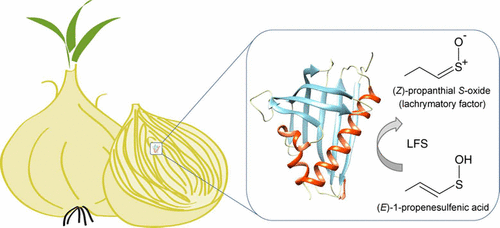当前位置:
X-MOL 学术
›
ACS Chem. Biol.
›
论文详情
Our official English website, www.x-mol.net, welcomes your feedback! (Note: you will need to create a separate account there.)
Enzyme That Makes You Cry–Crystal Structure of Lachrymatory Factor Synthase from Allium cepa
ACS Chemical Biology ( IF 4 ) Pub Date : 2017-07-26 00:00:00 , DOI: 10.1021/acschembio.7b00336 Josie A. Silvaroli 1 , Matthew J. Pleshinger 1, 2 , Surajit Banerjee 3, 4 , Philip D. Kiser 1, 5, 6 , Marcin Golczak 1, 6
ACS Chemical Biology ( IF 4 ) Pub Date : 2017-07-26 00:00:00 , DOI: 10.1021/acschembio.7b00336 Josie A. Silvaroli 1 , Matthew J. Pleshinger 1, 2 , Surajit Banerjee 3, 4 , Philip D. Kiser 1, 5, 6 , Marcin Golczak 1, 6
Affiliation

|
The biochemical pathway that gives onions their savor is part of the chemical warfare against microbes and animals. This defense mechanism involves formation of a volatile lachrymatory factor (LF) ((Z)-propanethial S-oxide) that causes familiar eye irritation associated with onion chopping. LF is produced in a reaction catalyzed by lachrymatory factor synthase (LFS). The principles by which LFS facilitates conversion of a sulfenic acid substrate into LF have been difficult to experimentally examine owing to the inherent substrate reactivity and lability of LF. To shed light on the mechanism of LF production in the onion, we solved crystal structures of LFS in an apo-form and in complex with a substrate analogue, crotyl alcohol. The enzyme closely resembles the helix-grip fold characteristic for plant representatives of the START (star-related lipid transfer) domain-containing protein superfamily. By comparing the structures of LFS to that of the abscisic acid receptor, PYL10, a representative of the START protein superfamily, we elucidated structural adaptations underlying the catalytic activity of LFS. We also delineated the architecture of the active site, and based on the orientation of the ligand, we propose a mechanism of catalysis that involves sequential proton transfer accompanied by formation of a carbanion intermediate. These findings reconcile chemical and biochemical information regarding thioaldehyde S-oxide formation and close a long-lasting gap in understanding of the mechanism responsible for LF production in the onion.
中文翻译:

使您从洋葱洋葱中分泌性分泌因子合酶的晶体结构变成晶体的酶
赋予洋葱风味的生化途径是针对微生物和动物的化学战的一部分。这种防御机制涉及形成挥发性的催泪因子(LF)((Z)-丙烷S-氧化物)会导致与洋葱切碎相关的眼睛刺激。LF是在催泪因子合酶(LFS)催化的反应中产生的。由于固有的底物反应性和LF的不稳定性,LFS促进亚硫酸底物转化为LF的原理很难通过实验进行检验。为了阐明洋葱中LF产生的机理,我们解析了APO形式并与底物类似物巴豆醇复合的LFS晶体结构。该酶非常类似于具有START(与星相关的脂质转移)结构域的蛋白质超家族的植物代表的螺旋握折特征。通过比较LFS与脱落酸受体PYL10(START蛋白超家族的代表)的结构,我们阐明了LFS催化活性背后的结构适应性。我们还描述了活性位点的结构,并基于配体的方向,我们提出了一种催化机制,该机制涉及相继的质子转移以及碳负离子中间体的形成。这些发现调和了有关硫醛的化学和生化信息形成S氧化物并弥合了长期的差距,以了解造成洋葱中LF产生的机理。
更新日期:2017-07-28
中文翻译:

使您从洋葱洋葱中分泌性分泌因子合酶的晶体结构变成晶体的酶
赋予洋葱风味的生化途径是针对微生物和动物的化学战的一部分。这种防御机制涉及形成挥发性的催泪因子(LF)((Z)-丙烷S-氧化物)会导致与洋葱切碎相关的眼睛刺激。LF是在催泪因子合酶(LFS)催化的反应中产生的。由于固有的底物反应性和LF的不稳定性,LFS促进亚硫酸底物转化为LF的原理很难通过实验进行检验。为了阐明洋葱中LF产生的机理,我们解析了APO形式并与底物类似物巴豆醇复合的LFS晶体结构。该酶非常类似于具有START(与星相关的脂质转移)结构域的蛋白质超家族的植物代表的螺旋握折特征。通过比较LFS与脱落酸受体PYL10(START蛋白超家族的代表)的结构,我们阐明了LFS催化活性背后的结构适应性。我们还描述了活性位点的结构,并基于配体的方向,我们提出了一种催化机制,该机制涉及相继的质子转移以及碳负离子中间体的形成。这些发现调和了有关硫醛的化学和生化信息形成S氧化物并弥合了长期的差距,以了解造成洋葱中LF产生的机理。



























 京公网安备 11010802027423号
京公网安备 11010802027423号